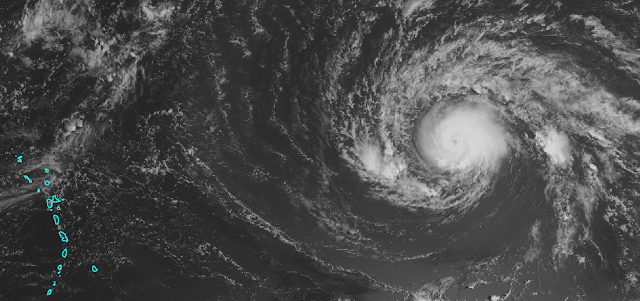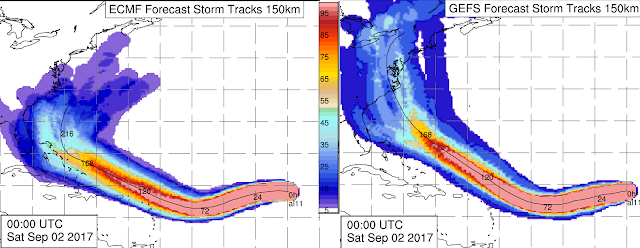
Irma is still a Category 3 hurricane and is centered just 600 miles east of the Leeward Islands as of Monday morning. The outermost rainband is about 250 miles from the islands as of this writing (and satellite loop below). Hurricane watches will be upgraded to hurricane warnings later today as dangerous tropical storm conditions should begin in those islands later tomorrow with the worst conditions arriving on Wednesday.
Over the past couple of days, the key feature that will determine how soon Irma turns toward the north -- the subtropical ridge -- has been expected to remain stronger for longer, keeping Irma stuck to the south. The pre-US recurvature scenario looks less likely all the time now.
 |
| Five-day track forecasts from the National Hurricane Center over the past couple of days (Saturday morning through Monday morning). |
This is bad news for a lot of places... from the Leeward islands, Puerto Rico, Dominican Republic, Haiti, Cuba, the Bahamas, and then the U.S.
Before diving into the specifics, the latest model ensemble guidance does indicate a later northward turn than was the case a couple of days ago. One tidbit to be aware of is that the mechanism that will provide a break in the ridge is a trough coming in from off the U.S. west coast. Days ago, that feature was not very well sampled with data to feed into the models. Now that it is entering the western U.S., it is coming into a more data-rich environment and models get a better grip on its structure. It is forecast to dive from the Pacific northwest down to the southeast US between Wednesday and Monday, eroding the ridge as it does so.
 |
| Ten-day track probabilities calculated from the ECMWF ensemble (left) and the GFS ensemble (right). (B. Tang, UAlbany) |
Both the European and the U.S. global model ensembles still include a sharp turn to the north, but the most recent runs are near the Florida peninsula, and they differ slightly on the timing. At this point, Florida is definitely at risk from at least a close encounter if not a direct landfall from a major hurricane. The southeast U.S. coast is also still at an elevated risk of significant impacts.
As far as timing goes, south Florida would be looking at the worst conditions on Sunday-Monday (10th-11th), with tropical storm force winds arriving on Saturday (9th). It remains to be seen what "worst" means as that is dependent on precisely how close the eyewall gets to a certain location.
If it turns north just prior to reaching the Florida peninsula, the Carolinas become a likely target, and the worst conditions would be on Monday-Tuesday (11th-12th) with tropical storm conditions arriving Monday (11th).
At this point, a westward track into and across the Gulf of Mexico seems very unlikely, but given the model trends, I wouldn't rule it out completely just yet. However, note the scenario where the storm turns north just after passing the Florida peninsula and tracks up the west coast of Florida. This threat cannot be ignored either.
If it seems like the "I" storms are historically troublesome, you'd be right. Storms that begin with "I" are in fact the most retired of all the storms. Names are permanently retired from the rotating lists if they were particularly deadly or devastating.
Breaking it down by month, storms that made their impact during September have also been the most commonly retired.
And finally, breaking it down by peak intensity, storms that reach Category 4 intensity are also the most frequently retired.






